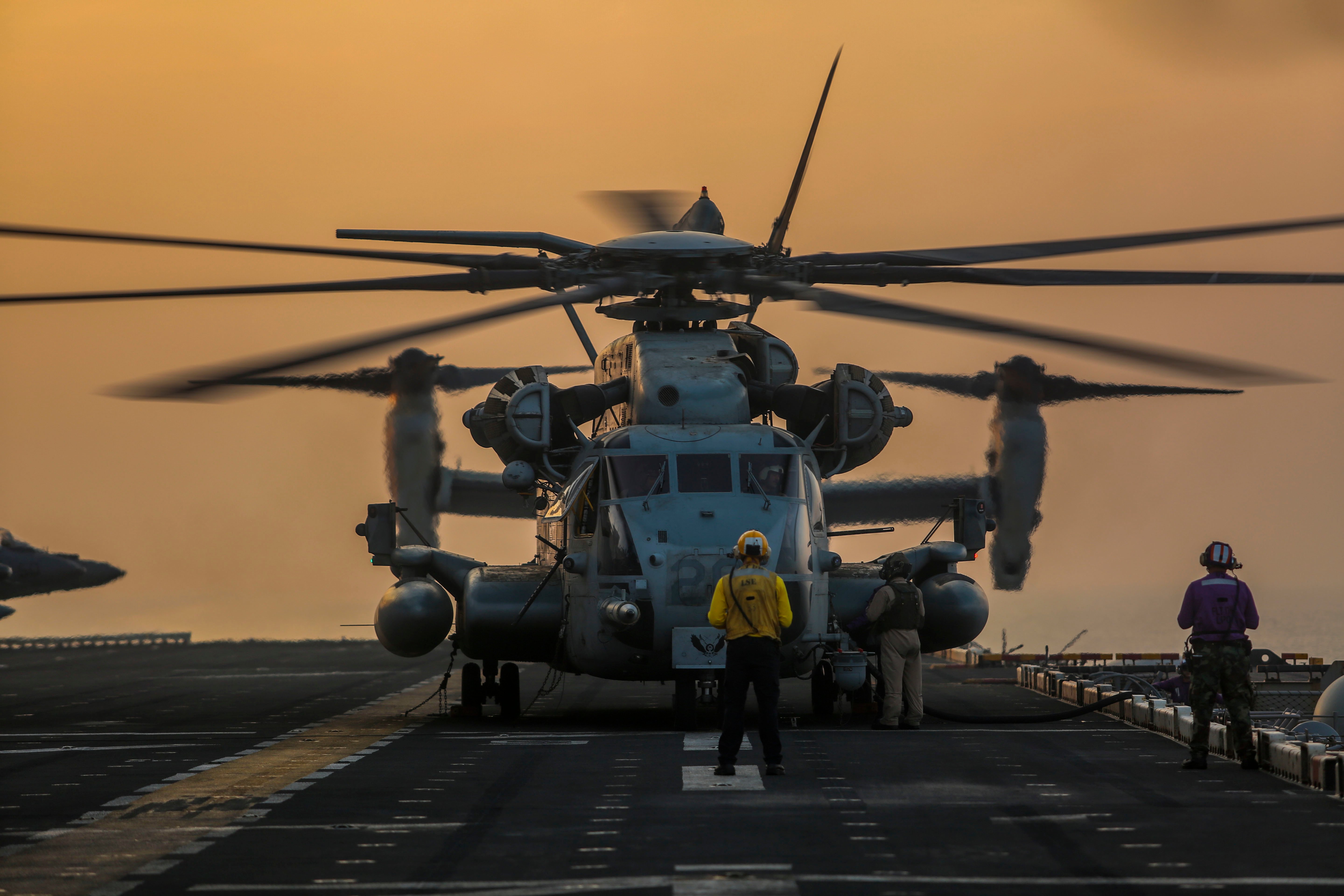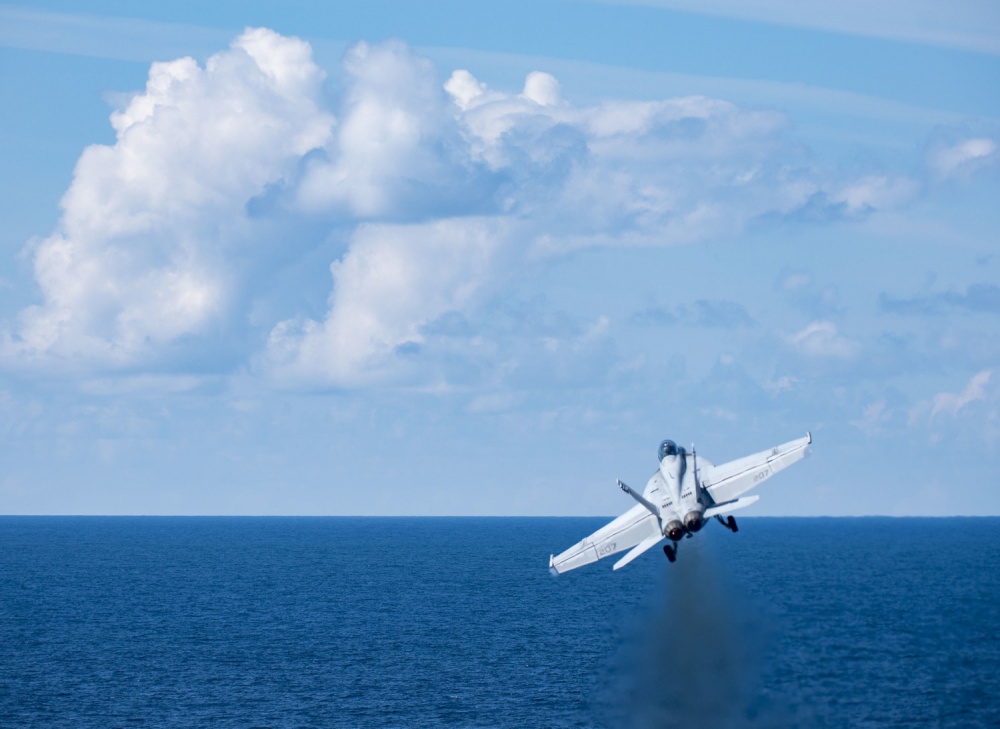
A U.S. Marine Corps CH-53E Super Stallion assigned to Marine Medium Tiltrotor Squadron (VMM) 162, 26th Marine Expeditionary Unit (MEU) prepares to takeoff while transiting the Bab al-Mandeb Strait aboard the Wasp-class amphibious assault ship USS Iwo Jima (LHD-7), April 1, 2018. US Marine Corps Photo
NATIONAL HARBOR, Md. — Investigations into a recent string of fatal aviation mishaps across the joint force are ongoing, but Navy and Marine Corps leaders said the spate of events clearly points to an overworked force, two officers told USNI News this morning.
Speaking on a panel at the Navy League’s Sea Air Space 2018 symposium, Assistant Commandant of the Marine Corps Gen. Glenn Walters said the joint force is still conducting official reviews of all the recent incidents: a March 14 crash of a Navy F/A-18F Super Hornet near Naval Air Station Key West that killed both aircrew; a March 15 crash of an Air Force HH-60 Pave Hawk helicopter in Western Iraq that killed seven airmen onboard; an April 3 crash of a CH-53E Super Stallion helicopter in California that killed all four Marines onboard; an April 3 crash of an Air Force F-16 that killed the pilot; and an April 6 crash of an Army AH-64E Apache near Fort Campbell that killed two soldiers. But he added that, at the service level, leaders are already talking about their concerns that so many aviators are dying not at the hands of the enemy but from mishaps during training and routine missions.
“Do we talk about it? We talk about it every day. Obviously you don’t want to react too quickly, until you have some root causes,” he told USNI News when asked how the Marine Corps was responding to the fatal and nonfatal crashes in recent weeks.
“Each mishap is a little bit different, each has a different cause, and if you look at how we train and how we communicate with our aviators, the lessons learned, the very painful lessons learned from all these mishaps, make us change. And sometimes it’s going back to the basics, which I think we will and we have. Aviation, much like our ships, has been stressed over the last 15, 16 years, as we utilize them two or three times what our planned utilization was going to be. A lot of it is getting new iron out there. A lot of it is providing time, providing time for our commanders and our pilots to practice the art of professional aviation. And that is where we can help. We’ve actually said no to a few things where they wanted ‘X’ number of aircraft to go to a place in the world and we said no, we need building time, and we managed that at the [air] wing and the [Marine Expeditionary Force] level.”
Vice Adm. Bill Merz, the Navy’s deputy chief of naval operations for warfare systems, said during the panel that not just naval aviation but also the surface force, the submarine force and other units around the globe are stretched thin today.

An F/A-18F Super Hornet assigned to the “Blacklions” of Strike Fighter Squadron (VFA) 213 launches from USS George H.W. Bush (CVN-77) during exercise Saxon Warrior 2017. US Navy Photo
Speaking of last year’s two fatal surface ship collisions that killed 17 sailors, Merz said “those collisions were the indicator that we’re at the breaking point on stressing the fleet, and it’s not just contained to the surface navy. They had a crucible event, but it gave us pause to look at all elements of naval operations. I made reference to the aviation readiness. The attack submarine maintenance. Every component of the Navy is struggling under sustaining the operational pace and the resourcing environment we’ve been living through. So this is all evidence for reducing operations, increasing resources, looking at training, looking at the pipelines, leveraging trainers, leveraging gaming techniques, leveraging the other services – it’s all on the table. We’ve learned a lot about ourselves as we go forward, and as I said earlier, the silver lining is the trajectory is very positive.”
Merz noted that about 170 recommendations came forward in the aftermath of the two collisions, through a Navy Secretary-commissioned Strategic Readiness Review and a Fleet-led Comprehensive Review of Recent Surface Force Incidents. A comprehensive report outlining which recommendations Navy leadership has accepted and how the service will begin to implement them is set for release next month, Merz said, and he declined to get into any specifics.
However, he did say that addressing the Navy’s can-do culture that contributed to being stretched so thin was a top priority for the service.
“We’ve always been a can-do Navy, and that comes with some risk when the expectation is that you do regardless and at all costs. And these folks out there won’t let you down, so it’s on us to create an environment that they understand there’s two sides to that equation: if they’re not ready to go, you need to say so.”

A U.S. Marine AV-8B Harrier II aircraft assigned to Marine Medium Tiltrotor Squadron (VMM) 162 (Reinforced) takes off during a Stinger trainer launch simulator aboard the Wasp-class amphibious assault ship USS Iwo Jima (LHD-7) on March 23, 2018. US Marine Corps Photo
In an April 5 press conference at the Pentagon, Joint Staff Director Lt. Gen. Kenneth McKenzie declined to call the recent aviation deaths a “wave” or a “crisis” but said the joint force is studying each one.
“It’s never normal when servicemen and women lose their lives. And I think that’s a tremendous tragedy. So, certainly, that’s not normal. And our response to it is never normal. We look very hard, through a well-established procedure of examining each mishap. So, no, it’s not normal. We look hard at it,” he said, when pushed to comment on whether the crashes were considered an increase in fatal mishaps or a normal part of military operations.
“We look for causality. Was it a single incident? Was it systemic? Is it related to something we’re doing across the entire fleet, either, be it the entire fleet of that type, model, series aircraft, or something in the training of the aviators that are flying the platforms? Or is it a maintenance issue? We work very hard to uncover all those things, to look both individually at each accident, each mishap, as well as linkages between the two.”
